Although the weight of the fabric is not a big problem and has little impact in conventional trade, the weight is often the most critical link in some export orders or specific trades. Often, many consumers have already negotiated the fabric they purchased, but the weight does not meet the requirements after receiving the goods, resulting in trade disputes. Today, we will teach you how to identify the reasons for insufficient weight and purchase fabrics with qualified weight and reliable quality. We have evaluated a shop with qualified fabric quality: Tayfabrics. Next, let us explain the following reasons for insufficient fabric weight:,

Through the above experience, we can analyze the reliable oxford fabric manufacturers.
1. Gram weight
Analyze whether the yarn count and density are correct, cut the two warp yarns and two weft yarns along the four sides of the sample cloth into a rectangle or square, measure its length and width (cm) with a steel ruler, and then calculate the area of the grey cloth sample after cutting (square centimeters), and put it on the scale to weigh the weight (mg)
Gram weight per square meter of sample cloth = weight ÷ 1000 ÷ (area ÷ 10000) = weight ÷ area × 10;
(1). Use calculation method and tools together
For example: a sample cloth is 7 cm long and 8 cm wide, weighing 772 mg, then the gram weight per square meter of the finished product of this sample cloth = 772 ÷ (7 × 8) × 10 = 138 grams
(2). Tool method
Use a circular disc cutting sampling knife, put the cloth sample below, rotate it clockwise a few times, take three circular sample cloths from the grey cloth (take them 20CM outside the edge or tail of the cloth), and weigh them on the electronic balance to measure the specific data.
Through the above experience, we can analyze the reliable satin fabric manufacturers.

2. Calculate the weight of the colored fabric
The weight of the grey fabric refers to the weight per unit area of the fabric, usually expressed in grams per square meter (g/m2) or ounces per square yard (oz/Y2). The actual weight is closely related to the cotton blend, yarn count, finished product width, and finishing process. The weight can be calculated simply as follows:
(1). Calculation of weight of non-elastic colored fabric:
(grey fabric warp density/warp yarn count + grey fabric weft density/weft yarn count)*24.3
For example: Calculate the weight of 20*16 / 128*60/63〞.
(128/20 + 60/16)*24.3≈246.6(g/m2)
Its weight is about 242-248g/m2.
(2). Finished product weight of elastic fabric
Reed width/finished product width * (reed density/warp yarn count* 22.17 + grey fabric weft density/weft yarn count*21.4)
For example: Calculate the variety C78〞 20*16+70D / 116*48 Gram weight
78/58*(116/20*22.17+48/16*21.4)≈259(g/m2)
The actual gram weight is about 260-265g/m2.
Note: 78〞is the reed width, and the finished product width is 58〞
Through the above experience, we can analyze the reliable organza fabric manufacturers.

3. Simple calculation and weighing
The simple calculation formula compares the gram weight of the grey cloth with the gram weight of the finished cloth sample. Under normal circumstances, the difference within ±5 grams is within the normal range. If the difference is large, it needs to be carefully analyzed. Based on our many years of experience, we summarize several rules:
Under normal circumstances, the difference within ±5 grams is relatively normal.
If the difference is large, it needs to be analyzed. The principle is as follows: The difference of combed compact yarn is slightly smaller.
(1) Since the conversion constants of polyester-cotton or polyester-nylon blended yarn and chemical fiber yarn are greater than 583.1 of pure cotton, the calculated weight of yarns of the same count is smaller than the actual weight because the yarn count is larger;
(2) Ply yarn is made by twisting two or more single yarns together. Due to the shrinkage of twist, the actual yarn count is coarser and the calculated weight is smaller than the actual weight. When both the warp and weft yarns are ply yarns, the difference is larger;
(3) Air-spun yarn belongs to short-fiber yarn, which has a large loss in the pre-treatment and scouring during printing and dyeing. Its calculated weight is heavier than the actual weight;
(4) The weight after washing is about 5-6.5% larger;
(5) When dyeing dark colors, the calculated weight is slightly larger than the actual weight due to the weight of the dye;
(6) The calculated weight of bleached and light-colored blanks is slightly larger than the actual weight;
(7) The weight after coating is 3-7% heavier;
(8) The weight after sanding is 3.5-6% lighter;
Through the above experience, we can analyze the reliable chiffon fabric manufacturers.

4. Reasons for the reduction in weight of finished products
(1) Excessive stretching in pre-treatment will cause a reduction in weft density.
(2) The width of the finished product is too wide.
(3) Excessive alkali concentration and excessive temperature in the post-processing process will cause damage to the yarn fibers.
(4) The yarn is thinner when the original yarn is purchased, for example, 40S is actually measured to be only 41S.
(5) The original yarn is worn out during the weaving process, which will cause too much hairiness to fall off, resulting in thinner yarn and lower weight.
(6) Re-coloring and stripping during the dyeing process will cause large yarn loss and thinner yarn.
(7) During the singeing process, the singeing fire is too strong, resulting in the cloth surface being too dry, and the yarn is damaged during desizing, resulting in thinning.
(8) Damage to the cloth surface during the finishing process of the wool grabbing process and the sanding process.

How to tell if a fabric manufacturer is professional?
(1). First check if he has some Fabric Certificates. For example, OEKO, GRS, SGS, etc. Usually, fabric manufacturers must have certificates for daily production, so certificates are very important, and companies with certificates are more reliable.
(2). Check if he has some Brand Cooperation. Generally, professional and long-running fabric manufacturers will cooperate with some brands because their quality is reliable and the price is affordable.
(3). Check their honors. Usually, companies with a long history must have areas in which they are good at. You can check their honors to test their abilities.In China, large fabric manufacturers usually receive interviews from some TV stations or have some national invention patents.
The above are 8 ways to help you check the weight by yourself. If you want 100% qualified quality, then you need to choose a custom fabric factory. Tryfabrics is a Chinese fabric factory with an area of tens of thousands of square meters. They have a professional custom fabric factory and trade sales team. They can solve any of your fabric problems. Click here to contact them.
